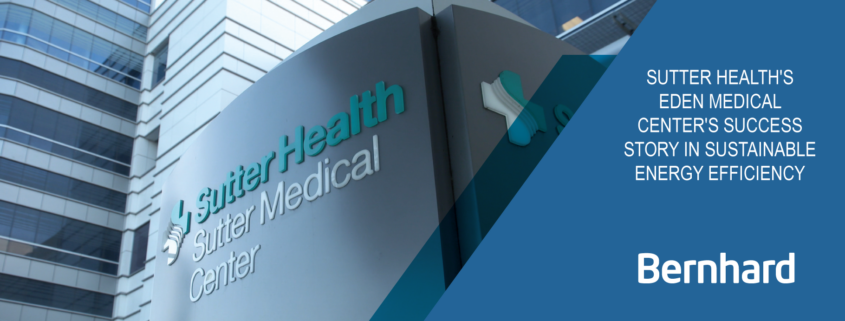Transforming Healthcare Facilities: Sutter Health’s Eden Medical Center’s Success Story in Sustainable Energy Efficiency
In an era where environmental sustainability is paramount, healthcare facilities across the globe are embracing innovative solutions to reduce their carbon footprint while simultaneously achieving significant cost savings. Sutter Health’s Eden Medical Center (EMC) stands out as a shining example of a healthcare institution that has successfully executed a comprehensive turnkey energy efficiency project, resulting in substantial financial savings and a substantial reduction in its environmental impact.
EMC’s journey toward energy efficiency was characterized by strong engagement from facility staff, diligent execution, and a commitment to long-term sustainability. The hospital’s partnership with Bernhard, a leading energy solutions provider, yielded remarkable results. The results of this energy project highlight the comprehensive strategies employed, the measurable outcomes achieved, and the broader implications for the healthcare industry.
The Scope of EMC’s Energy Efficiency Project
EMC’s energy efficiency project was no small feat. It encompassed a range of measures, each contributing to the overall goal of reducing energy consumption and greenhouse gas emissions while optimizing operational efficiency. The project’s primary objectives included:
- Upgrading to Energy-Efficient LED Lighting: A facility-wide LED lighting upgrade played a pivotal role in reducing electricity consumption.
- Enhancing Central Chilled Water Plant Operations: Operational improvements to the central chilled water plant significantly contributed to electric savings and overall system efficiency.
- Implementing Temperature Reset Strategies: Innovative strategies at the air handling units minimized reheat in spaces and reduced unnecessary load on the chiller plant, resulting in natural gas savings.
- Terminal Box Temperature Range Standardization: Terminal boxes were programmed to maintain zone temperatures within standardized ranges, saving cooling and reheat energy and promoting uniformity in temperature control.
- Optimizing Pump VFDs: Savings were generated from power reductions achieved through variable frequency drives on pumps.
- Chilled Water dP Reset/Adjustments: Chilled water secondary pressure controls reset based on AHU’s valve position/demand, optimizing chiller plant equipment staging for efficient operation.
- Air Handler Optimization: AHUs operated with supply air temperature resets based on terminal unit demand, reducing reheat and chiller plant load.
The Tangible Benefits: Measured Energy Savings
The success of EMC’s energy efficiency project is not just anecdotal; it is backed by concrete data. The project resulted in impressive energy savings, demonstrating its impact at both the system level and the utility bill level:
- Electric consumption decreased by 14%.
- Natural gas consumption decreased by 24%.
A thorough verification process, including regression curve analysis, weather normalization, and monitoring-based commissioning (MBCx) using SkySpark and Bernhard Analytics, confirmed these savings and is providing a deeper level of information to the building operators, improving their productivity in maintaining patient and staff comfort levels. The annual savings is $517,890, with a potential for even greater savings as utility rates escalate.
Sustainability Beyond Savings
EMC’s commitment to sustainability extends beyond the immediate financial benefits. Their approach to energy efficiency includes ongoing monitoring and evaluation through the MBCx program. Engineers from Bernhard collaborate with Sutter Health’s Eden Medical Center staff, ensuring the achieved savings persist and identifying additional opportunities for improvement.
Conclusion
Sutter Health’s Eden Medical Center’s energy efficiency journey serves as a compelling case study for the healthcare industry. Their multifaceted approach, measurement and verification, and ongoing commitment to sustainability showcase what is possible when healthcare facilities prioritize both environmental responsibility and fiscal prudence.
As healthcare institutions worldwide seek ways to reduce their carbon footprint and operational costs, EMC’s story provides a roadmap for success. By embracing energy efficiency projects with a holistic and long-term perspective, hospitals can not only save substantial sums but also contribute significantly to a more sustainable future for all.
EMC’s journey reminds us that energy efficiency is not just about reducing expenses; it’s about building a healthier, more sustainable world for generations to come.
About the Author:
Jane Guyer is a Sr. Director of Account Management in Bernhard’s Engineering Division with more than 20 years of engineering experience including 13 years as an energy efficiency specialist. Jane specializes in enterprise-level energy management and technical project development for large clients, including hospitals, higher education, and manufacturing facilities. Account management is a primary focus for Jane. She excels at providing clients with detailed budget planning, staff management, and technical guidance that aligns with their sustainability or energy management goals. Jane has performed or led recommissioning and energy project implementation projects in numerous healthcare and resort/hotel/casino facilities totaling over 19 million square feet of conditioned space and saving Bernhard’s clients over $2 million on an annual basis. Many of the facilities have undergone multi-year recommissioning efforts, enabling deeper dive recommissioning projects with higher levels of savings, savings persistence, and more creative energy efficiency solutions. Jane was named one of the Top 30 Women to Watch by Utah Business in 2022.




